
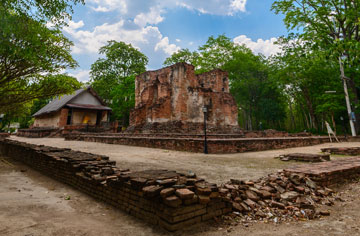
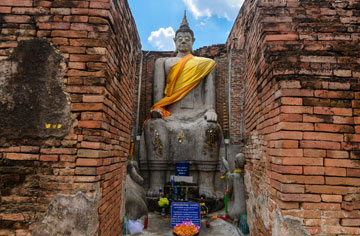

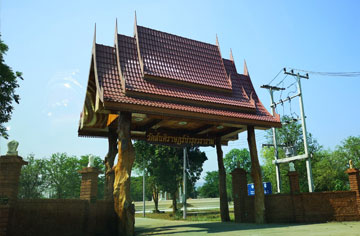
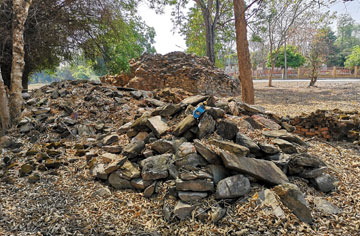
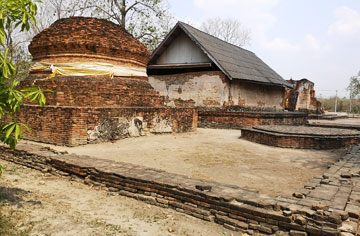

Ancient Town of Kanchanaburi used to be a border outpost confronting Burmese armies arriving through the Three Pagodas Pass since the Ayutthaya through Rattanakosin Periods. Mounds of the rectangular earthen wall measuring 167 x 355 sq.m. and four corner fortresses still remain to be seen. Ancient monuments within its vicinity include: Wat Pa Lelai, Wat Mae Mai Nuea, Wat Mae Mai Tai and Wat Nang Phim.
During the Ayutthaya period, Kanchanaburi was of strategic outpost confronting Burmese armies arriving through the Three Pagodas Pass. Then the ancient town was fianally abondonned during the Ayutthaya perid since the city was moved along The Kwai Yai River and Lam Ta Pern River in Pak Prak Sub-district. Many prehistoric objects and historic objects were found around the area thus, this site might be the route that the Indian civilization florished in Myanmar through the Gulf of Mattama and in Thailand through the Three Pagodas Pass. Furthermore there were the evidences of relationship between Kanchanaburi and other cities such as Suphanburi, Ratchaburi and Ayutthaya.
In 1924 Pra Kru Juay, a monk from Wat Nog Bua (Wat Sri Auparam, situated in Muang Distric), had kept the Buddhist Lent at Wat Khun Phan. Later he led villagers to explore the nearby areas and finally, they found 7 abandonned temples. Pra Kru Juay also named these temples and all of the names corresponded to some characters in the famous Thai epic “Khun Chang Khun Phan” such as Wat Khun Phean, Wat Khun Krai, Wat Nang Phim and etc.
In 1929, Pra Kru Juay and villgers renovated Wat Nang Phim and renamed Wat Kanchanaburi Kao. They also dug the nearby areas and found many antiques as well as a large number of Buddha amulets.
The historical sites are as follow: Wat Pa Lelai(Abandonned) was built in the Ayutthaya Period.There was once enshrined a seated Buddha image in the gesture of subduing Mara, which was drilled through the chest so the local called “Wat Pha Ok” in Thai. In 1974 monks from Wat Kanchanaburi Kao and villagers cast a Buddha image in the gesture of accepting offerings from an elephant and a monkey for a replacement. This attitude of the Buddha Image also intentionally corresponded to The Sepha “Khun Chang Khun Phan” (the famous Thai epic)
The interestiong sites are the following:
• Mondop (east facing). A Buddha Image in the attitude of accepting offerings from an elephant and a monkey is enshrined inside.
• Wihan situated between Mondop and Chedi. It was on a regtangular base and surrounded by opaque wall. The two entrances were in the West with the steps in the north and in the south.The roof was rebuilt.
• Chedi (stupa) . It was a circular brick Chedi coated with cement on a square base. The top was totally broken.
Wat Khun Phaen (Abandonned) was a large temple, situated around 500 meters to the north-east of Wat Pa Lelai. In 1989 Fine Arts Department had renovated all the ruind sites and had discovered some archelogogical sites. The sites are the following:
• Phra Prang was raised to it height of 15 meters. It might be enshrined the Lord Buddha’s relic. Phra Prang was in the Ayutthaya period. It was similar to a Prang at Sala Khao Sub-district, Muang District, Suphanburi, but the shape was smaller. It was a brick Prang coated with cement on the unadorned square base in the form of overturned and upturned lotus with 12 indented corners. The base was 9 meters long and 65 centimeters high. The upper part was formed into leaf-like lotus petal decorative element.The muti-pronged metal spire on the top fell down.
• Ubosoth, The base was made of brick and coated with cement. It measured 17.2 meters wide, 7.8 meters long and 2.5 meter high. The entrance was in the east. The interior desidn was in the Ayutthaya period.
• Satellite chedi (stupa). There were 12 brick chedi coated with cement. The top of all chedi fell down.
Wat Mae Mai (Abandonned) was built in the Ayutthaya Period and located around 300 meters to the east of Wat Khun Phaen. There are 2 groups of architectural remains. 'Sa Lang Kraduk' or 'bone-washing' pond was between these remains.
• Wat Mae Mai Nuea (north). There was a large round Chedi situated on a plinth and rectangular west-facing Wihan. The base was made of brick coated with cement and the top was fallen down.
• Wat Mae Mai Taii (south) The remains include a medium-scale east-facing Wihan, satellite Chedis and rectangular boundary wall.
Wat Nang Phim or Wat Kanchanaburi Kao. It had been renovated several times. Nowsady it is in ruins.
Location: Ban Tha Sao, Lad Ya Sub-district, Muang District, 20 kilometers from Kanchanaburi. How to get there By car : From Kaeng Seam intersection, drive on the highway 3199 until you reach Lad Ya intersection. Go straight about 2 kilometers. When you see the signpost said “ Wat Nang Phim’, turn left and drive on the road about 400 meters.